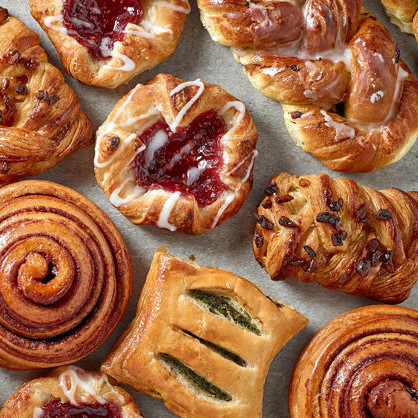
Pastry
What is a Pastry?
Pastry is a type of dough made with flour, water and shortening. Baked pastry dough can be sweet or savory, and consumed alone or with fillings. Pastry is characterized by its flaky and crumbly texture, and rich buttery flavor.1
- Shelf life of filled pastry is dependent on free water availability and susceptibility to moisture migration.
- Typical pastry shelf life ranges from a couple of days for meat-containing pastries, to a few weeks for high sugar fillings.1
- Shortcrust pastry
- Puff pastry or pâte feuilletée
- Choux pastry or pâte a choux
- Flaky pastry
- Phyllo pastry
- Suet crust pastry
- Rough puff pastry
- Hot water crust pastry
- Pâte sucrée pastry
Origin
Pastry dough may have originated in Egypt. However, its use in bakeries is attributed to the Greeks and Romans. Baklava, a type of phyllo dough, was created in the Roman empire. In the 17th century, pastry baking became extremely popular and several timeless creations such as puff pastry were developed then. Today, pastries are consumed worldwide and new variations are developed routinely.
Ingredients
Commonly used ingredients in pastry dough:2
| Ingredient | Type | Usage Level (Baker’s Percent) | Function |
|---|---|---|---|
| Flour | Pastry flour, low protein flour | 100% |
|
| Fat | Solid fats (butter or margarine) | 50-80 % |
|
| Sugar | White granulated sugar | 25 – 40 % |
|
| Salt | Granulated | 0.5 – 1.0 % |
|
| Water | Ice cold | 25 – 30 % |
|
Nutrition
Typical nutritional value of commercially available frozen pastry dough per 100 g:3
| Component | Grams |
|---|---|
| Carbohydrate | 60.25 |
| Water | 19.00 |
| Fat | 12.50 |
| Protein | 8.25 |
Pastry dough has a high fat and calorie content. A commercial frozen pastry dough provides 332 kcal per 100 g serving.3
Commercial production
Pie crust made with pastry dough is manufactured through the following process:4
- Weighing and scaling of the ingredients
- Mixing: flour and fat are mixed in a stainless steel vessel.
- Liquid addition: ice water is added , and gently mixed to avoid gluten development.
- Refrigeration: dough is cooled overnight.
Pressed crust (for small operations)
- Dividing and pressing: dough balls are formed and pressed into a pie plate.
- Filling: pie filling is deposited on the pie crust.
- Baking: pies are baked at 230-260 oC (450-500 oF), baking time will depend on the type of pie.
- Cooling: pies are cooled to room temperature for further processing.
- Packaging
Rolled crust (for large operations)
- Sheeting: dough is rolled using a sheeting machine to a specified width and thickness, and cut into rectangles.
- Rolling: using a cross rolling machine .
- Depositing and filling: button crust is placed in pan, and filling is deposited on dough. Finally, the top crust is placed on the pie,and is crimped and trimmed.
- Baking: pies are baked at 230-260 oC (450-500 oF), baking time will depend on the type of pie.
- Cooling: pies are cooled to room temperature for further processing.
- Packaging
Processing considerations
Some processing considerations when making pastry dough:4
- Mealy dough is made by blending fat and flour into an almost paste. Finer fat distribution though the dough retards water absorption.
- Flaky crust is prepared by coarsely blending flour and fat.
- Dough relaxation time is important to allow easier shaping and rolling.
- Dough chilling is extremely important, due to the solidified fat contribution to flaky texture.2
- Fats used for pastries should have high melting points.2
Regulations
Pastries include a wide range of products, and thus are governed by several FDA regulations. In general, all common pastry ingredients are GRAS. CFR Title 21, Part 101 specifies food labeling requirements for several products, including pastries.5
In the EU, pastries belong to the Cereal and Bakery Products category. Their ingredients are considered safe.6
References
- Kilcast, David, and Persis Subramaniam, eds. Food and beverage stability and shelf life. Elsevier, 2011.
- Figoni, P. I. How Baking Works: Exploring The Fundamentals Of Baking Science. 3rd ed., John Wiley & Sons, 2011.
- U.S. Department of Agriculture, Agricultural Research Service. FoodData Central, 30 October 2020.https://fdc.nal.usda.gov/fdc-app.html#/food-details/1817049/nutrients . Accessed 01 November 2018.
- Lallemand Inc,.”Pie Crust Production”. Lallemand Baking Update. Vol 3, no. 12, 2018, pp. 1-2., Accessed 27 June 2021.
- Food and Drug Administration (FDA). US Department of Health and Human Services. CFR Code of Federal Regulations Title 21, Part 101 Food Labeling, https://www.accessdata.fda.gov/scripts/cdrh/cfdocs/cfcfr/cfrsearch.cfm?fr=101.54 , Accessed 13 June 2021.
- Food Safety Authority of Ireland. Guidance Note On The EU Classification Of Food. Food Safety Authority Of Ireland, Dublin, 2001, p. 11.

